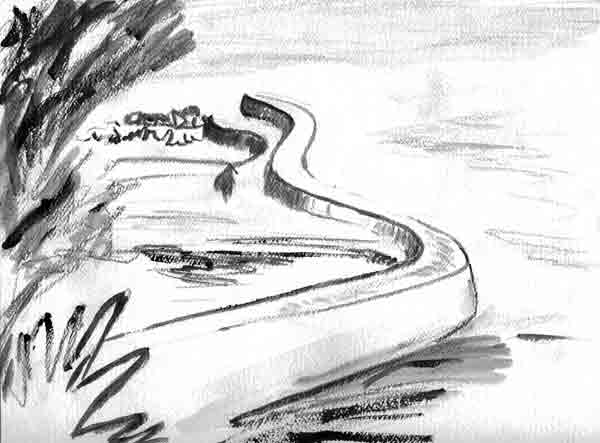The Lyme Maze Game

The path past the pines leads to the Undercliff. There are some preliminaries; you pass the head of a path coming up from the left alongside a stream, cross some meadows deep with horsetails, rest on a bench with a sunny view down over meadow and sea and the Cobb—
—go through a gate that says you are entering National Trust territory (and the next county, Devon). You join an unpaved road curving down from the right; pass a cottage and a last farmstead, called Undercliff Dairy. (At this point a path on the right descends from Chimney Rock.) Then you are in the Undercliff. At first it's quite tame, a forest through which goes a broad easy earthen way. I've even reached this far by bicycle, which I then hid in the undergrowth. The going becomes tougher. A notice warns that though it's only six miles through to the other end, it will take you more hours than you think, and you're advised to be in a party of three in case someone turns an ankle, falls down a crevice, or gets lost. (Mobile phones don't work in the Undercliff; and it looks unlikely that helicopters could land.) At times you're uncertain which is the path: it becomes a black thread, or several threads, some of which go tightroping along the tops of narrow banks, others dipping through sloughs beside them. For this is the nature of the terrain: a jumble of slices, slanting leftward (southward). High up to your right through the treetops you can sometimes discern the main cliff-line, beyond which is the different world of the open-fielded plateau. Below the cliff, the ground is spalling away in slices toward the sea. The slices slide over each other, lubricated by underground water. It is as if there are stacks of cards, or slates, leaning against a wall, and you are an ant trying to balance your way along the top edge of one, now another. The chasms between the slices: how deep are they? Some are quite small; others are masked by vegetation, could they be bottomless? Down to your right is a pond completely carpeted with the tiny bright-green blobs of duckweed. Later, a huger such pool, away down to the left; you almost expect a crocodile to rise through the green slime. The slices don't cease to slip. So, probably after every winter, the tangled topography has changed, and parts of the path have to be re-pioneered. You come to a cascade of steps, twisty and very steep, cut in the earth and retained with pieces of wood; you're almost sorry to get this artificial help in an otherwise totally wild place, but without the steps it would be a different matter to get down into the ravine, and across the stream at the bottom (you've ceased worrying about getting your feet wet) and up the other side. Most of the time, picking your way along in this jungle, you're hardly aware of the sea, hundreds of feet down to the left; you have rounded the indentation of Pinhay Bay almost without seeing it. Beside a high part of the path is a natural seat, the bough of a tree growing out horizontally before curving upward; this was where I used to come on mornings in 2001 to paint the horizonless sea framed by the trembly foliage of ash trees. about half way along, come to the water pumping station the Pinhay pumping station was installed in 1935, provided main water source for Lyme, from an underground spring, known locally as Hart's Tongue Spring because of the ferns, became redundant in 2004 when a landslide cut off the power supply, was removed in 2007 can get down, by a staircase path with a rope beside it, to the stony beach we bathed here walked back along the beach to Lyme but now the tide is in Charlton or Charton Bay 1851 the Angelique, a French ship of eighty tons, was driven ashore and wrecked in Charlton Bay four bodies were washed up on the beach at Lyme and buried in the churchyard reminiscent of the Blue Ridge, which was populated with and denuded by farming families up to the early twentieth century—though the Undercliff never became so un-wild. In 2003 two children (aged twelve and nine) found in the Undercliff a two-man tent; there were in it a mobile phone, bank statements, sleeping bags, an address book, books by C.S. Lewis, bags of trash tied up; leaves had piled over the tent, everything had gone mouldy, police deemed it had been there for at least six months. go on to the Great Landslip then to |
